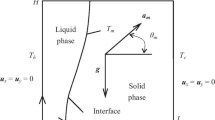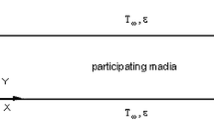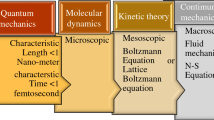Abstract
In this work, the heat transport phenomena coupled with melting process are studied by using the enthalpy-based lattice Boltzmann method (LBM). The proposed model is a modified version of thermal LB model, where could avoid iteration steps and ensures high accuracy. The Bhatnagar–Gross–Krook (BGK) approximation with a D1Q2 lattice was used to determine the temperature field for one-dimensional melting by conduction and multi-distribution functions (MDF) with D2Q9 lattice was used to determine the density, velocity and temperature fields for two-dimensional melting by natural convection. Different boundary conditions including Dirichlet, adiabatic and bounce-back boundary conditions were used. The influence of increasing Rayleigh number (from 103 to 105) on temperature distribution and melting process is studied. The obtained results show that a good agreement with the analytical solution for melting by conduction case and with the benchmark solution for melting by convection.







Similar content being viewed by others
Abbreviations
- c :
-
Lattice speed
- c p :
-
Specific heat at constant pressure
- c s :
-
Sound speed of the lattice
- e i :
-
Discrete lattice velocity in direction i
- En :
-
Total enthalpy
- En l :
-
Total enthalpy of the liquid phase
- En s :
-
Total enthalpy of the solid phase
- f l :
-
Volume fraction of liquid
- f i :
-
Particle distribution function in direction i for velocity field
- \(f_{i}^{eq}\) :
-
Equilibrium distribution function in direction i for velocity field
- F :
-
Buoyancy force
- g :
-
Acceleration due to gravity
- g i :
-
Particle distribution function in direction i for temperature field
- \(g_{i}^{eq}\) :
-
Equilibrium distribution function in direction i for temperature field
- l :
-
Appropriate length scale
- L f :
-
Latent heat of phase change
- Nu :
-
Nusselt number
- p :
-
Pressure
- Pr:
-
Prandtl number (ν/α)
- Ra :
-
Rayleigh number (gβΔTl 3/να)
- Ste :
-
Stefan number (c p ΔT/L f )
- t :
-
Time
- T :
-
Temperature
- T 0 :
-
Initial temperature
- T b :
-
Temperature of the left wall
- T m :
-
Melting temperature
- u :
-
Velocity
- Δt :
-
Lattice time step
- Δx :
-
Lattice space
- α :
-
Thermal diffusivity
- β :
-
Volume expansivity
- ε :
-
Small expansion parameter
- κ :
-
Thermal conductivity
- ν :
-
Kinematic viscosity
- ω i :
-
Weight coefficient in direction i
- Ω:
-
Collision operator
- τ, τ f , τ g :
-
Relaxation time
- *:
-
Dimensionless symbols
- k :
-
Iteration
- n :
-
Time step
References
Bertrand O, Binet B, Combeau H, Couturier S, Delannoy Y, Gobin D, Lacroix M, Quere PL, Medale M, Mencinger J, Sadat H, Vieira G (1999) Melting driven by natural convection a comparison exercise: first results. Int J Therm Sci 38(1):5–26
Tan L, Zabaras N (2006) A level set simulation of dendritic solidification with combine features of front-tracking and fixed-domain methods. J Comput Phys 211(1):36–63
Jin C, Xu K (2006) An adaptive grid method for two-dimensional viscous flows. J Comput Phys 218(1):68–81
Usmani AS, Lewis RW, Seetharamu KN (1992) Finite element modelling of natural-convection-controlled change of phase. Int J Numer Methods Fluids 14(9):1019–1036
Javierre E, Vuik C, Vermolen FJ, Van der Zwaag S (2006) A comparison of numerical models for one-dimensional Stefan problems. J Comput Appl Math 192(2):445–459
Mencinger J (2004) Numerical simulation of melting in two-dimensional cavity using adaptive grid. J Comput Phys 198(1):243–264
Wolfram S (1986) Theory and applications of cellular automata. World Scientific, Singapore
Frisch U, Hasslacher B, Pomeau Y (1986) Lattice-gas automata for the Navier–Stokes equation. Phys Rev Lett 56:1505–1508
McNamara G, Zanetti G (1988) Use of the Boltzmann equation to simulate lattice-gas automata. Phys Rev Lett 61:2332–2335
Wolf-Gladrow D (2000) Lattice-gas cellular automata and lattice Boltzmann models: an introduction. Springer, Heidelberg
Succi S (2001) The lattice Boltzmann equation for fluid dynamics and beyond numerical mathematics and scientific computation. Oxford University Press, Oxford
Thorne DT, Michael C (2006) Lattice Boltzmann modeling: an introduction for geoscientists and engineers. 2nd edn, Springer, Heidelberg
Mohamad AA (2011) Lattice Boltzmann method fundamentals and engineering applications with computer codes. Springer, London
Guo Z, Shu C (2013) Lattice Boltzmann method and its applications in engineering. World Scientific, Singapore
Wolf-Gladrow D (1995) A lattice Boltzmann equation for diffusion. J Stat Phys 79(5):1023–1032
De Fabritiis G, Mancini A, Mansutti D, Succi S (1998) Mesoscopic models of liquid/solid phase transitions. Int J Modern Phys C 9:1405–1416
Miller W (2001) The lattice Boltzmann method: a new tool for numerical simulation of the interaction of growth kinetics and melt flow. J Cryst Growth 230(1–2):263–269
Miller W, Succi S (2002) A lattice Boltzmann model for anisotropic crystal growth from melt. J Stat Phys 107(1–2):173–186
Miller W, Rasin I, Pimentel F (2004) Growth kinetics and melt convection. J Cryst Growth 266(1–3):283–288
Medvedev D, Kassner K (2005) Lattice Boltzmann scheme for crystal growth in external flows. Phys Rev E 72(5):056703
Rasin I, Miller W, Succi S (2005) Phase-field lattice kinetic scheme for the numerical simulation of dendritic growth. Phys Rev E 72(6):066705
Miller W, Rasin I, Succi S (2006) Lattice Boltzmann phase-field modelling of binaryalloy solidification. Phys A Stat Mech Appl 362(1):78–83
Jiaung W-S, Ho J-R, Kuo C-P (2001) Lattice Boltzmann method for the heat conduction problem with phase change. Numer Heat Transf B Fundam 39(2):167–187
Chatterjee D, Chakraborty S (2005) An enthalpy-based lattice Boltzmann model for diffusion dominated solid–liquid phase transformation. Phys Lett A 341(1–4):320–330
Huber C, Parmigiani A, Chopard B, Manga M, Bachmann O (2008) Lattice Boltzmann model for melting with natural convection. Int J Heat Fluid Flow 29(5):1469–1480
Semma E, El Ganaoui M, Bennacer R (2007) Lattice Boltzmann method for melting/solidification problems. Comptes Rendus Mécanique 335(5–6):295–303
Semma E, El Ganaoui M, Bennacer R, Mohamad AA (2008) Investigation of flows in solidification by using the lattice Boltzmann method’’. Int J Therm Sci 47(3):201–208
Chakraborty S, Chatterjee D (2007) An enthalpy-based hybrid lattice-Boltzmann method for modelling solid–liquid phase transition in the presence of convective transport. J Fluid Mech 592:155–176
Chatterjee D (2009) An enthalpy-based thermal lattice Boltzmann model for nonisothermal systems. EPL (Europhys Lett) 86(1):14004
Chatterjee D (2010) Lattice Boltzmann simulation of incompressible transport phenomena in macroscopic solidification processes. Numer Heat Transf B Fundam 58(1):55–72
Nemati H, Farhadi M, Sedighi K, Darzi AAR (2010) Lattice Boltzmann simulation of nanofluid in lid-driven cavity. Int Commun Heat Mass Transf 37(10):1528–1534
Eshraghi M, Felicelli SD (2012) An implicit lattice Boltzmann model for heat conduction with phase change. Int J Heat Mass Transf 55(9–10):2420–2428
Huang RZ, Wu HY, Cheng P (2013) A new lattice Boltzmann model for solid–liquid phase change. Int J Heat Mass Transf 59:295–301
Chapman S, Cowling TG (1990) The mathematical theory of non-uniform gases: an account of the kinetic theory of viscosity, thermal conduction and diffusion in gases. Cambridge University Press, Cambridge
Shan X (1997) Simulation of Rayleigh–Bénard convection using a lattice Boltzmann method. Phys Rev E 55(3):2780–2788
He X, Chen S, Doolen GD (1998) A novel thermal model for the lattice Boltzmann method incompressible limit. J Comput Phys 146(1):282–300
Guo Z, Shi B, Zheng C (2002) A coupled lattice BGK model for the Boussinesq equations. Int J Numer Methods Fluids 39(5):325–342
Alexiades V, Solomon AD (1993) Mathematical modeling of melting and freezing processes. Taylor & Francis, London
de Vahl Davis G (1983) Natural convection of air in a square cavity: a benchmark numerical solution. Int J Numer Methods Fluids 3(4):249–264
Ladd AJC (1994) Numerical simulations of particulate suspensions via a discretized Boltzmann equation, part I, theoretical foundation. J Fluid Mech 271:285–309
Ladd AJC (1994) Numerical simulations of particulate suspensions via a discretized Boltzmann equation, part II, numerical results. J Fluid Mech 271:311–339
Jany P, Bejan A (1988) Scaling theory of melting with natural convection in an enclosure. Int J Heat Mass Transf 31(6):1221–1235
Author information
Authors and Affiliations
Corresponding author
Rights and permissions
About this article
Cite this article
Ibrahem, A.M., El-Amin, M.F., Mohammadein, A.A. et al. Lattice Boltzmann technique for heat transport phenomena coupled with melting process. Heat Mass Transfer 53, 213–221 (2017). https://doi.org/10.1007/s00231-016-1811-8
Received:
Accepted:
Published:
Issue Date:
DOI: https://doi.org/10.1007/s00231-016-1811-8




